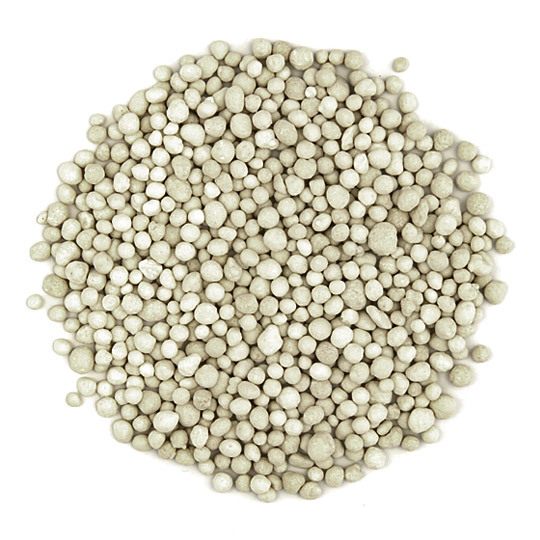NP 20:20 + 13 S

General information
Agropolychim AD (JSC) in parallel with the traditionally offered and known to the agricultural manufacturers products as ammonium nitrate, triple superphosphate, monoammonium sulphate and diammonium phosphate includes in its product list also complex combined NP and NPK fertilizers with or without microelements.
NPK fertilizers are complex highly efficient combined fertilizers with contents of the main macro-nutritional elements nitrogen, phosphorus and potassium. Advantage of the combined fertilizers is the contents of micro-nutritional elements and there are contents of sulphur in some of them. The fact that all the needed nutritional elements needed by the plant in the initial phases of its development are collected in one granule makes the NPK fertilizers very productive.
Except for stock fertilization they may also be used during vegetation for provision of the crops with nutritional substances in the critical phases of their development. The forms in which the nutritional elements are placed in the NPK fertilizers do not exert any impact over the acidity of the soils.
The potassium form is presented as potassium sulphate which makes it suitable for assimilation by the plant and contributing to the assimilation of the remaining nutritional elements.
The fertilizers which are with contents of potassium with chloride base provide a prerequisite for acidification of the medium around the root of the plant and blocking the receipt of a certain group of macro-nutritional elements.
Due to their balanced form and the comparatively low contents of active substance the NPK fertilizers are very suitable for correcting fertilization. Fertilization during vegetation with NPK predisposes to bigger percentage of assimilation by the plants than if other one- and two-components “heavy” fertilizers are used. NP is nitrogen-phosphorus fertilizer, created for feeding soils which are provided with potassium in contents. It is suitable for fertilization of almost all the crops both at pre-sewing preparation and for correcting fertilization. NP has comparatively low contents of easy to assimilate in form nutritional elements which makes it the good solution for each farm.
The balanced contents of nutritional elements contribute to the full satisfaction of the needs of the plants of macro-nutritional substances.
The contents of more than one element in the fertilizer also contribute to the better assimilation of the nutritional elements by the roots of the plants. In the presence of phosphorus the nitrogen is assimilated in greater degree by the plants and the availability of more than one nutritional element in usable form contributes to the development of the plant organism of full value.
The ratio of the elements and the easily usable form, which they are in the NPK fertilizers in, makes them suitable for satisfying the needs of the plants in each stage of their vegetative development.
The selection of the specific formulations depends on the conditions and the kind of the grown up crops. The use of NP and NPK fertilizers guarantees maximal efficiency of the input means and provides balanced supply of nutritional substances of full value.
⊳ NP and NPK fertilizers are stored in covered, cold and dry warehouse premises.
⊳ Heating and mixing with water are not desirable.
Advantages
Applied in an appropriate programme for balanced fertilization with a view to the requirements of the specific crop, the type of soil and the microclimate of the area, the complex fertilizers have the following advantages:
- Controlled release of nutritional elements.
- Significant increase of the coefficient of use of the nutritional elements.
- Possibility for accurate and controlled input of comparatively low norms of a certain element, which is difficult to attain with separate fertilization.
- Reduction of the losses from washing and flying off of the nutritional elements.
- Lower expenditures at one-time input into the soil - transportation, time and labor.
Customs tariff number
3105510090
Active substance calculator
| № | Physical (kg) | Active (kg): N | Active (kg): P | Active (kg): S |
| 1 | 5 | 1 | 1 | 0.65 |
| 2 | 10 | 2 | 2 | 1.3 |
| 3 | 15 | 3 | 3 | 1.95 |
| 4 | 20 | 4 | 4 | 2.6 |
| 5 | 25 | 5 | 5 | 3.25 |
| 6 | 30 | 6 | 6 | 3.9 |
Technical specification
| PARAMETER | NORM | HARMONIZED ANALYTICAL STANDARDS | |||||
| Total Nitrogen (N), % | 20,0 ± 1.5 | BDS EN 15750 | |||||
| Ammoniacal Nitrogen, % | 19,0 ± 1.5 | BDS EN 15475 | |||||
| Total Phosphorus pentaoxide (Р2О5), % | 20,0 ± 1.5 | BDS EN 15956 ; BDS EN 15959 | |||||
| Phosphorous pentaoxide (Р2О5), soluble in neutral ammonium citrate, % | 20.0 ± 1.5 | BDS EN 15957; BDS EN 15959 | |||||
| Phosphorous pentaoxide (Р2О5), soluble in water, % | 18,0 ± 1.5 | BDS EN 15958 ; BDS EN 15959 | |||||
| Total Sulphur (S),% | 13,0 -0.8/+1.6 | BDS EN 15960 ; BDS EN 15749 | |||||
| Content of Water*, % | max. 2.0 | BDS EN 13466-1 | |||||
| Cadmium (Cd)*, mg/kg Р2О5 | max. 60 | BDS EN 16319 + А1 | |||||
| Hexavalent Chromium (Cr VI)*, mg/kg dry matter | max. 2 | BDS EN 16318 + А1 | |||||
| Mercury (Hg)*, mg/kg dry matter | max. 1 | BDS EN 16320 + А1 | |||||
| Nickel (Ni)*, mg/kg dry matter | max. 100 | BDS EN 16319 + А1 | |||||
| Lead (Pb)*, mg/kg dry matter | max. 120 | BDS EN 16319 + А1 | |||||
| Arsenic (As)*, mg/kg dry matter | max. 40 | BDS EN 16317 + А1 | |||||
| Granulometry: granules 1-5 mm | min. 98 | BDS EN 1235 | |||||
* Parameters are not required for labeling according to Regulation 2019/1009 of EU fertilizing products. Determined at request and once / 3 months.